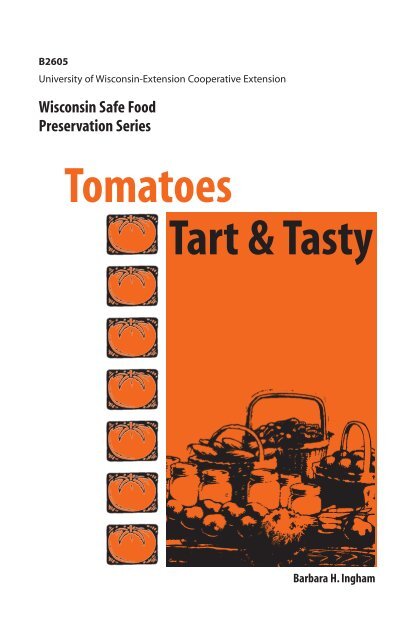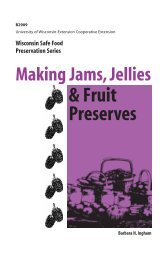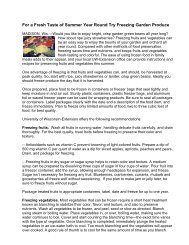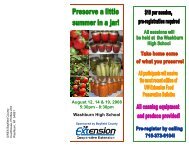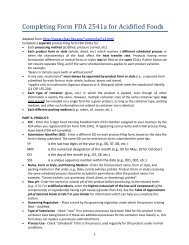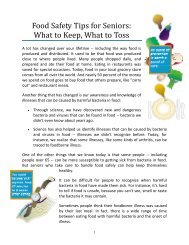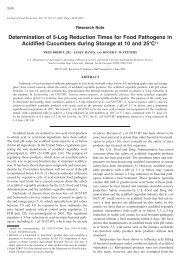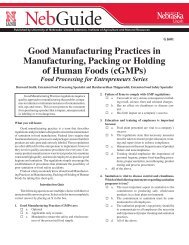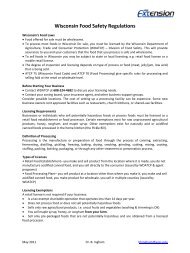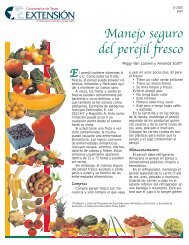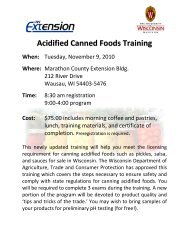B2605 Can tomatoes - UW Food Safety and Health - University of ...
B2605 Can tomatoes - UW Food Safety and Health - University of ...
B2605 Can tomatoes - UW Food Safety and Health - University of ...
Create successful ePaper yourself
Turn your PDF publications into a flip-book with our unique Google optimized e-Paper software.
Add citric acid or lemonjuice to home-cannedtomato productsbefore processing to ensure a safeproduct. Add 1 ⁄4 teaspoon citric acid or1 tablespoon bottled lemon juice perpint; add 1 ⁄2 teaspoon citric acid or2 tablespoons bottled lemon juice perquart. Do not substitute vinegar forlemon juice, an unsafe product mayresult.Since so many factors affect theacidity <strong>of</strong> canned <strong>tomatoes</strong> <strong>and</strong>juices — <strong>and</strong> because it is impracticalif not impossible for the homecanner to measure the pH <strong>of</strong> eachcontainer canned — USDA recommendsthat acid be added tohome-canned tomato products.Citric acid is effective at increasingthe acidity <strong>of</strong> <strong>tomatoes</strong> <strong>and</strong> tomatoproducts without changing theflavor. Citric acid is widely available indrugstores <strong>and</strong> where canningsupplies are sold.Use 1 ⁄2 teaspoon citric acid perquart or 1 ⁄4 teaspoon per pint.You can also use bottled lemonjuice to acidify canned <strong>tomatoes</strong>.Add 1 tablespoon per pint or2 tablespoons per quart. Measurethis amount into canning jars beforesealing. You can add a small amount<strong>of</strong> sugar — 1 teaspoon per quart —to <strong>of</strong>fset the acid taste, if you desire.Small amounts <strong>of</strong> vinegar are not aseffective as lemon juice in increasingacidity. Enough vinegar to increasethe acidity <strong>of</strong> canned <strong>tomatoes</strong>changes the flavor. For this reason,vinegar is not recommended as anacidifier in plain canned <strong>tomatoes</strong> orjuice. However, vinegar (5% aceticacid) is fine in catsup, chili sauce <strong>and</strong>salsa.4 Wisconsin Safe <strong>Food</strong> Preservation Series
Processing in apressure cannerPressure canners may have dialgauges or weighted gauges. Pressureis measured in pounds per squareinch (psi). When pressure is applied,water boils at a high temperature.<strong>Food</strong> can be processed in a pressurecanner quickly <strong>and</strong> safely at thesehigh temperatures. For homecanning, use pressure canners thatcan maintain pressures up to 15 psi.Be sure your canner is in good condition.Check your dial gauge cannerfor accuracy every canning season.The pressure required to ensuresafety <strong>of</strong> canned food varies with elevation.Wisconsin elevations rangefrom 580 to 1,953 feet above sealevel, with about two-thirds <strong>of</strong> thestate at elevations between 1,000<strong>and</strong> 2,000 feet. Adjust for elevationwhen canning.For pressure canning:■ Put 2 to 3 inches <strong>of</strong> hot water inthe canner. Place filled jars on therack, using a jar lifter. Fastencanner lid securely. Leave weight<strong>of</strong>f vent port or open petcock.Heat at the highest setting untilsteam flows from the petcock orvent port.Elevation mapRemember to adjust for elevationabove sea level whencanning <strong>tomatoes</strong>. To determineyour elevation, consult the elevationmap on this page, or call yourcounty L<strong>and</strong> Information <strong>of</strong>fice(listed under county government inyour phone book). If you sharerecipes with friends <strong>and</strong> relatives,be sure to include adjustments forchanges in elevation.Elevation above 1,000 feetElevation below 1,000 feet6 Wisconsin Safe <strong>Food</strong> Preservation Series
■■■■■Maintain high heat setting <strong>and</strong>exhaust steam for 10 minutes.Research supports the need tovent all types <strong>of</strong> pressure cannersfor 10 minutes. If the steam in thecanner is mixed with air, temperatureswill not get high enough.Once the canner is vented, placethe weighted gauge on the ventport or close the petcock (for a dialgauge canner). The canner willpressurize during the next 3 to5 minutes.Start timing the process when thepressure reading on the dialgauge indicates that the recommendedpressure has beenreached, or when the weightedgauge begins to jiggle or rock.Follow recipe directions precisely,using the process time listed forthe type <strong>of</strong> pressure canner, pack<strong>and</strong> jar size.Regulate heat under the canner tomaintain a steady pressure at orslightly above the correct gaugepressure. Pressure variationsduring processing may causeunnecessary liquid losses fromjars.When the timed process is completed,turn <strong>of</strong>f the heat, removecanner from the burner if possible,<strong>and</strong> let the canner depressurize.Do not force-cool the canner.Forced cooling may result in foodspoilage. Cooling the canner with■cold running water or opening thevent port before the canner is fullydepressurized will cause liquid lossfrom jars <strong>and</strong> seal failures. Forcedcooling may also warp the cannerlid <strong>of</strong> older model canners, causingsteam leaks.After the canner is depressurized,remove the weight from the ventport or open the petcock. Wait2 minutes, unfasten the lid, <strong>and</strong>remove it carefully. Lift the lidaway from you so that the steamdoes not burn your face. Removejars with a lifter, place on a towelor cooling rack <strong>and</strong> allow to cool.The only approvedmethods for canning<strong>tomatoes</strong> <strong>and</strong> tomatobasedproducts are pressure canning<strong>and</strong> boiling water canning. Followinstructions precisely, using the timelisted in each recipe for the canningmethod you choose. Open kettlecanning, microwave canning <strong>and</strong> ovencanning are very unsafe.T O M A T O E S T A R T & T A S T Y 7
Boiling water canningBoiling water canning can be easy todo at home using any large pot witha tight-fitting lid.For boiling water canning:■ Use a rack to keep jars fromtouching the canner bottom <strong>and</strong>to allow heat to reach all sides <strong>of</strong>the filled jars.■ Put jars into a canner that containssimmering (180°F) water.■ Add boiling water if needed tobring water 1 to 2 inches above jartops. Do not pour water directlyon the jars. Place a tight-fittingcover on the canner. If you use apressure canner for boiling watercanning, leave the cover unfastened<strong>and</strong> the petcock open toprevent pressure buildup.■ Bring water to a rolling boil. Set atimer for the processing time therecipe gives for the type <strong>of</strong> pack<strong>and</strong> jar size. Watch closely to keepwater boiling gently <strong>and</strong> steadily.Add boiling water if necessary tokeep jars covered.■ Follow recipe directions precisely,using the process time listed forboiling water canning.■Remove jars from the cannerimmediately after the timersounds. The food could spoil if jarsare left in hot water too long.Unsafe canning methodsOpen-kettle canning <strong>of</strong> <strong>tomatoes</strong>,tomato juice or other tomatoproducts is very unsafe. Becausethis method involves packing hot<strong>tomatoes</strong> in jars <strong>and</strong> sealing themwithout any further heat processing,microorganisms may survive <strong>and</strong> theproduct can spoil or becomehazardous.Microwave canning <strong>and</strong> ovencanning are also very unsafe.Thickening products by addingflour, cornstarch or modifiedstarches, such as with populartomato or spaghetti sauces, slows theprocessing <strong>of</strong> these products.Thickened tomato products can spoilor be unsafe to eat.Never add a thickening agent totomato products before canning.You may thicken these productsbefore serving. Thickened condensedtomato soup can be successfullyfrozen, but shouldnever be homecanned.8 Wisconsin Safe <strong>Food</strong> Preservation Series
Process timesThe type <strong>of</strong> pack — whole, quartered,hot or raw — <strong>and</strong> packingliquid — tomato juice or water —affect process times, as do otheringredients, canning method <strong>and</strong> jarsize.When you look at instructions in thefollowing recipes, you will notice thatraw, whole <strong>tomatoes</strong> packed intomato juice require significantlylonger process times in a boilingwater canner than any other tomatoproduct. This is because juice transfersheat to whole, raw <strong>tomatoes</strong> lessefficiently than water.Pressure canning is the least timeconsumingmethod to choose if youwant to can raw-packed <strong>tomatoes</strong> intomato juice.Filling jarsFollow the manufacturer’s directionsfor pretreating two-piece vacuumseal lids. Fill hot, clean canning jarswith tomato products. Be careful notto leave any food on the jar rims.Wipe jar rims with a clean, damppaper towel. Put on pretreated lids<strong>and</strong> screw on metal b<strong>and</strong>s until youbegin to feel resistance, then turn theb<strong>and</strong> until it is firmly tight.Cooling jars afterprocessingPut jars on a rack or cloth so air cancirculate freely around them. Do notuse a fan to cool jars, <strong>and</strong> avoid colddrafts. Do not retighten screw b<strong>and</strong>safter processing.Testing for sealTest each jar for a seal the day aftercanning. Jars with flat metal lids aresealed if:■ Lid has popped down in thecenter.■ Lid does not move when presseddown.If a jar is not sealed, refrigerate it <strong>and</strong>use within a few weeks, or reprocesswithin 24 hours.Reprocessing —or detecting spoilageJars <strong>of</strong> <strong>tomatoes</strong> or tomato productsthat do not seal may be safelyreprocessed within 24 hours.To reprocess:Remove lids <strong>and</strong> empty the <strong>tomatoes</strong><strong>and</strong> liquid into a pan. If a hot pack iscalled for, heat to boiling. For rawpack, you do not need to heat the<strong>tomatoes</strong> before packing into jars.Place <strong>tomatoes</strong> (heated or “raw”) inclean, hot jars. Put on new pretreatedlids. Process again for the full time.T O M A T O E S T A R T & T A S T Y 9
Twice-processed foods are safe, butthe quality may be lower. The texturechanges, <strong>and</strong> more heat-sensitivenutrients are lost, such as vitamin <strong>Can</strong>d B-complex vitamins.To detect spoilage:Spoilage has occurred if processed<strong>tomatoes</strong> sealed at first <strong>and</strong> thenunsealed a few days later. Do notreprocess such jars. Safely dispose <strong>of</strong>the contents so no human or animalwill consume them.The most common reasons homecannedtomato products spoil are:■ under-processing or■ incomplete seals.Tomatoes that have not beenprocessed long enough to destroymolds <strong>and</strong> heat-resistant bacteriamay spoil during storage. Carefullyinspect jars for signs <strong>of</strong> spoilagebefore use. Signs <strong>of</strong> spoilage mayinclude bubbling in the jars, bulginglids, or the appearance <strong>of</strong> mold underthe lid or on the top layer <strong>of</strong> food inthe jar.Sometimes food is spoiled evenwithout obvious signs <strong>of</strong> spoilage.Never use <strong>tomatoes</strong> or tomatoproducts where the jar seal hasbroken or there are obvious signs <strong>of</strong>spoilage such as bulging lids,bubbling or frothing <strong>of</strong> jar contents,or a strong sour smell when you liftthe jar lid.Do not taste spoiled food. Followthe instructions below for safely discardingspoiled food.Process <strong>tomatoes</strong> for thecorrect length <strong>of</strong> time toavoid spoilage. Carefullyinspect jars for signs <strong>of</strong> spoilage beforeuse. Safely discard any product withobvious signs <strong>of</strong> spoilage such as moldgrowth, bulging lid or sour smell.Safely discard spoiled foodCarefully dispose <strong>of</strong> spoiled tomatoproducts in one <strong>of</strong> two ways:■ If the suspect jars are still sealed,place them in a heavy garbagebag. Close <strong>and</strong> place the bag in aregular trash container or bury itin a nearby l<strong>and</strong>fill.■ If the suspect jars are unsealed,open or leaking, detoxify the jars<strong>and</strong> their contents before discarding.Detoxifying the jars <strong>and</strong> theircontents will destroy any poisonsthat might have formed.To detoxify food:Carefully place the filled suspect jars<strong>and</strong> lids on their sides in an 8-quart orlarger stock pot, pan or boiling watercanner. Wash your h<strong>and</strong>s thoroughly.Carefully add to the pot enoughwater to cover the jars by 1 or 2inches. Avoid splashing the water.10 Wisconsin Safe <strong>Food</strong> Preservation Series
Place a lid on the pot <strong>and</strong> heat thewater to boiling. Boil 30 minutes toensure detoxifying the food <strong>and</strong> jars.Cool. Discard the jars, their lids <strong>and</strong>food in the trash, or bury in soil.Wash with soap <strong>and</strong> water allcounters, pots <strong>and</strong> equipmentincluding can opener, clothing <strong>and</strong>h<strong>and</strong>s that may have contacted thespoiled food or jars. Discard anysponges or wash cloths that mayhave been used in the cleanup. Placethem in a plastic bag <strong>and</strong> discard inthe trash.Tomatoes that failed toseal may be safelyreprocessed within24 hours. Empty <strong>tomatoes</strong> from jars,heat if hot packing, <strong>and</strong> ladle intoclean, hot jars. Put on new pretreatedlids. Reprocess again for the full time.Safely discard <strong>tomatoes</strong> that are spoiledor that became unsealed. If the spoiledjars are still sealed, place them in aheavy garbage bag. Close <strong>and</strong> placethe bag in a regular trash container orbury it in a nearby l<strong>and</strong>fill. If suspectjars are unsealed, open or leaking,detoxify the jars <strong>and</strong> their contentsbefore discarding.Storing canned<strong>tomatoes</strong>Wipe cool jars. Label with the date<strong>and</strong> contents <strong>of</strong> the jar. Remove thescrew b<strong>and</strong>s to avoid rust.Store jars in a cool, dark place. Forbest eating quality <strong>and</strong> nutritivevalue, use within one year. Heat,freezing temperatures, light ordampness will decrease the quality<strong>and</strong> shelf life <strong>of</strong> canned food.Freezing <strong>tomatoes</strong>Tomatoes can also be successfullypreserved by freezing. Any <strong>of</strong> thetomato sauces in this publication canbe frozen with excellent results.To freeze whole or quartered<strong>tomatoes</strong>, prepare as you would forhot-pack canned <strong>tomatoes</strong>. Chill theheated <strong>tomatoes</strong> <strong>and</strong> pack int<strong>of</strong>reezer containers, leaving 1-inchheadspace. Seal, label <strong>and</strong> date, <strong>and</strong>freeze at 0° F or lower.Tomato products thickened withflour, cornstarch or modified starchmust be frozen. These productscannot be safely canned at home.Use frozen <strong>tomatoes</strong> as you wouldcanned <strong>tomatoes</strong>. Use within oneyear for best quality.T O M A T O E S T A R T & T A S T Y 11
Tomatoes —Crushed, quartered, hotpack (no added liquid)1. Wash high-quality, firm, ripe<strong>tomatoes</strong>.2. Dip in boiling water for 30 to60 seconds or until skin splits.Then dip in cold water, slip <strong>of</strong>fskins, remove cores, <strong>and</strong> cut intoquarters.3. Crush some <strong>of</strong> the quartered<strong>tomatoes</strong> in a large kettle whileheating rapidly. Gradually addremaining quartered <strong>tomatoes</strong>,stirring constantly. After all<strong>tomatoes</strong> are added, boil gentlyfor 5 minutes.4. Add 1 ⁄2 teaspoon citric acid or2 tablespoons bottled lemonjuice to each quart jar; add1⁄4 teaspoon citric acid or 1 tablespoonbottled lemon juice toeach pint. Add 1 teaspoon salt <strong>and</strong>1 teaspoon sugar per quart, ifdesired. Fill clean, hot canning jarswith hot <strong>tomatoes</strong>, leaving 1 ⁄2-inchheadspace.R E C I P E S5. Remove excess air from the jar byrunning a spatula or bubble freerbetween the <strong>tomatoes</strong> <strong>and</strong> theside <strong>of</strong> the jar in several places.6. Wipe jar rims, <strong>and</strong> cap withproperly pretreated lids. Adjustlids. Process using one <strong>of</strong> the threemethods below.Hot pack crushed <strong>tomatoes</strong>Boiling water canner—process time0- 1001-Jar size 1000 ft 3000 ftpints 35 min. 40 min.quarts 45 min. 50 min.Dial gauge canner—process timecanner pressure (psi)Jar size process time 0-2000 ftpints 20 min. 6 lb.quarts 15 min. 11 lb.Weighted gauge canner—process timecanner pressure (psi)process 0- aboveJar size time 1000 ft 1000 ftpints 20 min. 5 lb. 10 lb.quarts 15 min. 10 lb. 15 lb.Note: lb. = pound tbsp. = tablespoon tsp. = teaspoonFor pressure canning, pressure is measured in pounds per square inch (psi).T O M A T O E S T A R T & T A S T Y 13
Tomatoes— Whole orhalves, in juice pack1. Wash fully ripe <strong>tomatoes</strong>. Dip inboiling water for 30 to 60 secondsor until skin splits. Then dip in coldwater, slip <strong>of</strong>f skins, <strong>and</strong> removecores. Follow steps for raw pack ORhot pack.2. To clean, hot canning jars add 1 ⁄2teaspoon citric acid or 2 tablespoonsbottled lemon juice toeach quart jar; add 1 ⁄4 teaspooncitric acid or 1 tablespoonbottled lemon juice to each pint.Add 1 teaspoon salt <strong>and</strong>1 teaspoon sugar per quart, ifdesired.Fill jars:3. Raw pack: Leave whole or cut inhalves <strong>and</strong> place in clean, hotcanning jars. Cover <strong>tomatoes</strong> withhot tomato juice, leaving 1 ⁄2-inchheadspace.Hot pack: Place prepared<strong>tomatoes</strong> in a saucepan <strong>and</strong> addenough tomato juice to covercompletely. Boil gently 5 minutes.Fill jars with hot <strong>tomatoes</strong> <strong>and</strong>cover with hot tomato juice,leaving 1⁄2-inch headspace.4. Remove excess air from the jar byrunning a spatula or bubble freerbetween the <strong>tomatoes</strong> <strong>and</strong> theside <strong>of</strong> the jar in several places.5. Wipe jar rims, <strong>and</strong> cap withproperly pretreated lids. Adjustlids. Process using one <strong>of</strong> the threemethods belowHot or raw pack in juiceBoiling water canner—process time0- 1001-Jar size 1000 ft 3000 ftpints 85 min. 90 min.quarts 85 min. 90 min.Dial gauge canner—process timecanner pressure (psi)Jar size process time 0-2000 ftpints 40 min. 6 lb.quarts 25 min. 11 lb.Weighted gauge canner—process timecanner pressure (psi)process 0- aboveJar size time 1000 ft 1000 ftpints 40 min. 5 lb. 10 lb.quarts 25 min. 10 lb. 15 lb.Juice transfers heatmuch less effectivelythan water. Tomatoespacked in juice have a much longerprocessing time than <strong>tomatoes</strong> packedin water. Read through each recipecompletely before processing to makesure you are producing a safe product.T O M A T O E S T A R T & T A S T Y 15
Tomatoes—Whole orhalves (raw packwithout added liquid)1. Wash <strong>tomatoes</strong>. Dip in boilingwater for 30 to 60 seconds or untilskins split, then dip in cold water.Slip <strong>of</strong>f skins <strong>and</strong> remove cores.Leave whole or halve.2. To clean, hot canning jars add 1 ⁄2teaspoon citric acid or 2 tablespoonsbottle lemon juice toeach quart jar; add 1 ⁄4 teaspooncitric acid or 1 tablespoon bottlelemon juice to each pint. Add 1teaspoon <strong>of</strong> salt per quart to thejars, if desired.Fill jars:3. Raw pack: Fill jars with raw<strong>tomatoes</strong>, leaving 1 ⁄2-inch headspace.Press <strong>tomatoes</strong> in the jarsuntil spaces between them fillwith juice. Leave 1 ⁄2-inch headspace.4. Remove excess air from the jar byrunning a spatula or bubble freerbetween the <strong>tomatoes</strong> <strong>and</strong> theside <strong>of</strong> the jar in several places.5. Wipe jar rims, adjust lids <strong>and</strong>process.Each recipe gives abouthow many whole vegetablesto use as a guide inpreparing the chopped amount. Donot rely on these whole vegetablequantities, but carefully measure allingredients in each recipe.Raw pack without added liquidBoiling water canner—process time0- 1001-Jar size 1000 ft 3000 ftpints 85 min. 90 min.quarts 85 min. 90 min.Dial gauge canner—process timecanner pressure (psi)process 0- 2001-Jar size time 2000 ft 4000 ftpints 40 min. 6 lb. 7 lb.quarts 25 min. 11 lb. 12 lb.Weighted gauge canner—process timecanner pressure (psi)process 0- aboveJar size time 1000 ft 1000 ftpints 40 min. 5 lb. 10 lb.quarts 25 min. 10 lb. 15 lb.16 Wisconsin Safe <strong>Food</strong> Preservation Series
Tomato juice1. Select fully ripe <strong>tomatoes</strong>. You willneed about 22 pounds <strong>tomatoes</strong>for 7 quarts <strong>of</strong> juice, 101⁄2 poundsfor 7 pints.2. Wash <strong>tomatoes</strong>, remove stems <strong>and</strong>cores. To prevent juice from separating,quickly quarter 1 pound <strong>of</strong><strong>tomatoes</strong> directly into a saucepan.Immediately heat to boiling whilecrushing. Continue to slowly addfreshly cut quarters to the boilingmixture, crushing as you addthem. Stir frequently to preventscorching. Simmer 5 minutes onceall <strong>tomatoes</strong> are added.3. Strain through a fine sieve or foodmill to separate juice from skins<strong>and</strong> seeds. If you have a blender,blend the hot <strong>tomatoes</strong> for a fewseconds before straining to obtainmore pulp.4. To clean, hot canning jars add 1 ⁄2teaspoon citric acid or 2 tablespoonsbottled lemon juice toeach quart jar; add 1 ⁄4 teaspooncitric acid or 1 tablespoon bottledlemon juice to each pint. Add1 teaspoon salt <strong>and</strong> 1 teaspoonsugar per quart, if desired.5. Reheat strained juice <strong>and</strong> pourinto prepared jars leaving 1 ⁄2 inchheadspace.6. Remove excess air from the jar byrunning a spatula or bubble freerbetween the <strong>tomatoes</strong> <strong>and</strong> theside <strong>of</strong> the jar in several places.7. Wipe jar rims, <strong>and</strong> cap withproperly pretreated lids. Adjustlids. Process using one <strong>of</strong> the threemethods below.Hot pack tomato juiceBoiling water canner—process time0- 1001-Jar size 1000 ft 3000 ftpints 35 min. 40 min.quarts 40 min. 45 min.Dial gauge canner—process timecanner pressure (psi)process 0- 2001-Jar size time 2000 ft 4000 ftpints 20 min. 6 lb. 7 lb.quarts 15 min. 11 lb. 12 lb.Weighted gauge canner—process timecanner pressure (psi)process 0- aboveJar size time 1000 ft 1000 ftpints 20 min. 5 lb. 10 lb.quarts 15 min. 10 lb. 15 lb.When preparing tomatojuice, blending the raw<strong>tomatoes</strong> before heatingis not recommended. It hastens enzymaticbreakdown <strong>of</strong> pectin <strong>and</strong> causesthe juice to separate. Instead, rapidlyheating the raw <strong>tomatoes</strong> inactivatesthe enzyme <strong>and</strong> keeps the juice fromseparating.T O M A T O E S T A R T & T A S T Y 17
Tomato-vegetablejuice blend8 quarts fully ripe <strong>tomatoes</strong>, cored <strong>and</strong>quartered (20 to 25 lbs.)1 cup onions, chopped (2 medium)1 cup carrots, peeled (2 medium)1 cup celery, chopped (3 stalks)Optional: 1 cup green peppers, cored(2 medium) — Substitute for 1 cupother vegetables to total 3 cups.2 bay leaves, as desired3 tbsp. salt, as desired1. Wash fully ripe <strong>tomatoes</strong>, removestems <strong>and</strong> cores. Crush <strong>and</strong> simmeras for making tomato juice. Chop orblend onion, celery, carrots <strong>and</strong>/orgreen peppers <strong>and</strong> add to<strong>tomatoes</strong>. Season as desired withsalt or bay leaf. Add no more than3 cups <strong>of</strong> vegetables for every 22pounds <strong>of</strong> <strong>tomatoes</strong>.2. Heat rapidly to boiling <strong>and</strong> simmer20 minutes.3. Strain through a fine sieve or foodmill to separate juice from skins<strong>and</strong> seeds. If you have a blender,blend the hot mixture for a fewseconds before straining to obtainmore pulp.4. To clean, hot canning jars, add1⁄2 tsp. citric acid or 2 tbsp.bottled lemon juice to eachquart jar; add 1 ⁄4 tsp. citric acidor 1 tbsp. bottled lemon juice toeach pint.5. Reheat juice to boiling <strong>and</strong> add toprepared jars leaving 1 ⁄2 inchheadspace. Remove excess airfrom the jar by running a spatulaor bubble freer between the juice<strong>and</strong> the side <strong>of</strong> the jar.6. Wipe jar rims, <strong>and</strong> cap withproperly pretreated lids. Adjustlids. Process using one <strong>of</strong> the threemethods below, or freeze.To freeze: Pour strained juice into apot. Chill in a sink <strong>of</strong> ice cold water.Stir frequently until cool. Pour intorigid freezer containers, leaving1-inch headspace. Label <strong>and</strong> date.Freeze at 0° F or lower. For bestquality, use within one year.Hot pack juice blendBoiling water canner—process time0- 1001-Jar size 1000 ft 3000 ftpints 35 min. 40 min.quarts 40 min. 45 min.Dial gauge canner—process timecanner pressure (psi)process 0- 2001-Jar size time 2000 ft 4000 ftpints 20 min. 6 lb. 7 lb.quarts 15 min. 11 lb. 12 lb.Weighted gauge canner—process timecanner pressure (psi)process 0- aboveJar size time 1000 ft 1000 ftpints 20 min. 5 lb. 10 lb.quarts 15 min. 10 lb. 15 lb.18 Wisconsin Safe <strong>Food</strong> Preservation Series
Tomato sauce or purée —No other vegetables added1. Prepare <strong>tomatoes</strong> as you would forplain tomato juice (see recipe onpage 17). You may add salt, sugar,bay leaf or garlic for seasoning.2. After straining, simmer in a largekettle until sauce thickens:■ For thin sauce, reduce thevolume by one-third.■ For purée, reduce the volumeby one-half.■ For paste, cook until the mixturerounds up on a spoon.Note: Process very thick sauce inpint or half-pint jars, not quarts.3. To clean, hot canning jars add1⁄2 teaspoon citric acid or2 tablespoons bottled lemonjuice to each quart jar; add1⁄4 teaspoon citric acid or 1tablespoon bottled lemon juiceto each pint. Add 1 ⁄2 teaspoonsalt <strong>and</strong> 1 ⁄2 teaspoon sugar perpint, if desired.4. Pour boiling hot sauce intoprepared jars, leaving 1⁄4-inchheadspace. Remove air bubbles,wipe jar rims, <strong>and</strong> cap withproperly pretreated lids. Adjust lids.5. Process or freeze.To freeze: Pour hot sauce into a pot.Chill in a sink <strong>of</strong> ice cold water. Stirfrequently until cool. Pour into rigidfreezer containers, leaving 1-inchheadspace. Label <strong>and</strong> date. Freeze at0° F or lower. For best quality, usewithin one year.Hot pack tomato sauceBoiling water canner—process time0- 1001-Jar size 1000 ft 3000 ftpints 35 min. 40 min.quarts 40 min. 45 min.Dial gauge canner—process timecanner pressure (psi)process 0- 2001-Jar size time 2000 ft 4000 ftpints 20 min. 6 lb. 7 lb.quarts 15 min. 11 lb. 12 lb.Weighted gauge canner—process timecanner pressure (psi)process 0- aboveJar size time 1000 ft 1000 ftpints 20 min. 5 lb. 10 lb.quarts 15 min. 10 lb. 15 lb.Yield informationAmount <strong>of</strong>Amount <strong>of</strong>fresh <strong>tomatoes</strong> canned <strong>tomatoes</strong>1 bushel = 18 quarts22 pounds = 7 quarts101⁄2 pounds = 7 pints3 pounds = 1 quartT O M A T O E S T A R T & T A S T Y 19
Stewed <strong>tomatoes</strong>4 quarts <strong>tomatoes</strong>, peeled, cored<strong>and</strong> chopped (24 large)1 cup celery, chopped (3 stalks)1⁄2 cup onion, chopped (1 medium)1⁄4 cup green pepper, seeded<strong>and</strong> chopped1 tbsp. sugar2 tsp. saltYield: 7 pints or 3 quarts1. Wash fully ripe <strong>tomatoes</strong>. Dip inboiling water for 30 to 60 secondsor until skin splits. Then dip in coldwater, slip <strong>of</strong>f skins, remove cores<strong>and</strong> chop. Prepare other ingredientsas directed.2. Combine all ingredients in a largestock pot. Cover, heat to boiling<strong>and</strong> simmer 10 minutes, stirring toprevent sticking. Ladle hot vegetablesinto clean, hot canning jars,leaving 1-inch headspace.3. Remove excess air from the jar byrunning a spatula or bubble freerbetween the <strong>tomatoes</strong> <strong>and</strong> theside <strong>of</strong> the jar in several places.4. Wipe jar rims, <strong>and</strong> cap withproperly pretreated lids. Adjustlids.5. Do not process in a boiling watercanner. Process using one <strong>of</strong> thetwo pressure canning methods onthe left or freeze.Do not increase theamount <strong>of</strong> vegetables instewed <strong>tomatoes</strong>, anunsafe product may result. For a safemixed vegetable recipe, see <strong>Can</strong>ningVegetables Safely (B1159), availablefrom your county <strong>UW</strong>-Extension <strong>of</strong>ficeor the address on the back page.Each recipe gives about how manywhole vegetables to use as a guide inpreparing the chopped amount. Donot rely on these whole vegetablequantities, but carefully measure allingredients in each recipe.Hot pack stewed <strong>tomatoes</strong>Dial gauge canner—process timecanner pressure (psi)process 0-Jar size time 1000 ftpints 15 min. 11 lb.quarts 20 min. 11 lb.Weighted gauge canner—process timecanner pressure (psi)process 0-Jar size time 1000 ftpints 15 min. 10 lb.quarts 20 min. 10 lb.Note: Safe processing informationfor elevations above 1,000 feet havenot been established for this recipe.20 Wisconsin Safe <strong>Food</strong> Preservation Series
Tomatoes with okra orzucchini—hot pack1. Wash <strong>tomatoes</strong> <strong>and</strong> okra orzucchini. Dip <strong>tomatoes</strong> in boilingwater 30 to 60 seconds or untilskins split. Then dip in cold water,slip <strong>of</strong>f skins <strong>and</strong> remove cores,<strong>and</strong> quarter. Trim stems from okra<strong>and</strong> slice into 1-inch pieces orleave whole. Slice or cube zucchiniif used. Bring <strong>tomatoes</strong> to a boil<strong>and</strong> simmer 10 minutes. Add okraor zucchini <strong>and</strong> boil gently 5minutes.2. Fill clean, hot canning jars withmixture, leaving 1-inch headspace.Add 1 teaspoon salt to eachquart, if desired.3. Remove air bubbles, adjust lids <strong>and</strong>process.Variation: You may add four or fivepearl onions or two onion slices toeach jar.Hot pack <strong>tomatoes</strong>with okra or zucchiniDial gauge canner—process timecanner pressure (psi)process 0- 2001-Jar size time 2000 ft 4000 ftpints 30 min. 11 lb. 12 lb.quarts 35 min. 11 lb. 12 lb.Weighted gauge canner—process timecanner pressure (psi)process 0- aboveJar size time 1000 ft 1000 ftpints 30 min. 10 lb. 15 lb.quarts 35 min. 10 lb. 15 lb.T O M A T O E S T A R T & T A S T Y 21
Meatless spaghetti sauce10 quarts fully ripe <strong>tomatoes</strong>, peeled <strong>and</strong>chopped (30 lbs.)1 cup onion, chopped (1 medium)1 cup green pepper (cored) or celery,chopped (2 medium peppers or3 stalks celery)1⁄4 cup parsley, chopped (optional)1 pound fresh mushrooms, sliced(optional)2 to 4 cloves garlic, minced1 tbsp. salt1⁄4 cup brown sugar1 tbsp. sweet basil, crushed1 tbsp. oregano1⁄4 cup vegetable oil (optional)Yield: About 9 pints1. Wash ripe <strong>tomatoes</strong>. Dip in boilingwater for 30 to 60 seconds or untilskin splits.Then dip in cold water<strong>and</strong> slip <strong>of</strong>f skins, core <strong>and</strong> quarter.Place in a large saucepan <strong>and</strong> boil20 minutes, uncovered, to thicken.Meanwhile, sauté onions, garlic,celery or peppers, <strong>and</strong> mushroomsin vegetable oil until tender.2. Combine sautéed vegetables with<strong>tomatoes</strong>. Bring to a boil. Simmeruncovered until thickened, about11⁄2 hours. Stir <strong>of</strong>ten to preventsticking.3. Ladle into clean, hot canning jars,leaving 1-inch headspace. Removeair bubbles, wipe jar rims, <strong>and</strong> capwith properly pretreated lids.Adjust lids.4. Do not process in a boiling watercanner. Process using one <strong>of</strong> thetwo pressure canning methodsbelow.Hot pack spaghetti sauceDial gauge canner—process timecanner pressure (psi)process 0- 2001-Jar size time 2000 ft 4000 ftpints 20 min. 11 lb. 12 lb.quarts 25 min. 11 lb. 12 lb.Weighted gauge canner—process timecanner pressure (psi)process 0- aboveJar size time 1000 ft 1000 ftpints 20 min. 10 lb. 15 lb.quarts 25 min. 10 lb. 15 lb.Do not add meat toMeatless SpaghettiSauce before canning,unsafe food will result. If desired,brown <strong>and</strong> add ground beef when youreheat the canned spaghetti sauce forserving. Seasonings in this recipe maybe decreased, if desired. Do not alterproportions <strong>of</strong> onions, peppers ormushrooms, or add pasta, rice orsimilar ingredients.22 Wisconsin Safe <strong>Food</strong> Preservation Series
Spaghetti sauce with meat30 lbs. <strong>tomatoes</strong>2 1 ⁄2 lbs. ground beef or sausage5 cloves garlic, minced1 cup chopped onions1 cup chopped celery or green peppers1 lb. fresh mushrooms, sliced (optional)4 1 ⁄2 tsp. salt2 tbsp. oregano4 tbsp. minced parsley2 tsp. black pepper1 ⁄4 cup brown sugarYield: About 9 pints1. Wash <strong>tomatoes</strong> <strong>and</strong> dip in boilingwater for 30 to 60 seconds or untilskins split. Dip in cold water <strong>and</strong>slip <strong>of</strong>f skins. Remove cores <strong>and</strong>quarter <strong>tomatoes</strong>. Boil 20 minutes,uncovered, in large saucepan. Putthrough food mill or sieve.2. Saute beef or sausage until brown.Add garlic, onion, celery or greenpepper <strong>and</strong> mushrooms, if desired.Cook until vegetables are tender.Combine with tomato pulp inlarge saucepan. Add spices, salt,<strong>and</strong> sugar. Bring to a boil. Simmer,uncovered, until thick enough forserving. At this time initial volumewill have been reduced by nearlyone-half. Stir frequently to avoidburning.3. Fill clean, hot jars, leaving 1-inchheadspace. Remove bubbles,adjust lids <strong>and</strong> process.Hot pack spaghetti saucewith meatDial gauge canner—process timecanner pressure (psi)process 0- 2001-Jar size time 2000 ft 4000 ftpints 60 min. 11 lb. 12 lb.quarts 70 min. 11 lb. 12 lb.Weighted gauge canner—process timecanner pressure (psi)process 0- aboveJar size time 1000 ft 1000 ftpints 60 min. 10 lb. 15 lb.quarts 70 min. 10 lb. 15 lb.T O M A T O E S T A R T & T A S T Y 23
Blender tomato catsup8 quarts <strong>tomatoes</strong>, chopped(about 24 lbs.)2 lbs. onions, chopped2 lbs. sweet peppers, mix <strong>of</strong> red <strong>and</strong>green, seeded <strong>and</strong> chopped3 tbsp. dry mustard1 1 ⁄2 tbsp. paprika1 1 ⁄2 tsp. whole allspice1 1 ⁄2 tbsp. whole cloves2 3-inch cinnamon sticks9 cups brown sugar, firmly packed1⁄4 cup canning or pickling salt9 cups cider vinegar (5% acetic acid)Yield: About 9 pints1. Wash fully ripe <strong>tomatoes</strong> <strong>and</strong> allvegetables. Dip <strong>tomatoes</strong> inboiling water for 30 to 60 secondsor until skins split. Then dip in coldwater <strong>and</strong> slip <strong>of</strong>f skins, core <strong>and</strong>quarter. Remove seeds frompeppers <strong>and</strong> slice into strips. Peel<strong>and</strong> quarter onions. Blend<strong>tomatoes</strong>, peppers <strong>and</strong> onions athigh speed for 5 seconds in anelectric blender or food processor.2. Pour into a 3- to 4-gallon stock potor large kettle <strong>and</strong> heat to boiling.Boil gently 60 minutes, stirring frequently.3. Add vinegar, brown sugar, salt, <strong>and</strong>a spice bag containing mustard,red pepper <strong>and</strong> other spices.Continue boiling <strong>and</strong> stirring untilvolume is reduced one-half <strong>and</strong>catsup rounds up on a spoon withno separation <strong>of</strong> liquid <strong>and</strong> solids(about 1 to 2 hours). As mixturethickens, stir <strong>of</strong>ten <strong>and</strong> reduceheat to prevent scorching.4. Pour hot catsup into clean, hotpint canning jars, leaving 1 ⁄8-inchheadspace. Remove air bubbles,wipe jar rims, <strong>and</strong> cap withproperly pretreated lids.Adjust lids.5. Process pints in a boiling watercanner:0-1,000 feet 15 minutes1,001-6,000 feet 20 minutesTo freeze: Chill quickly. Pour int<strong>of</strong>reezer containers, leaving 1-inchheadspace. Label <strong>and</strong> date. Freeze at0° F or lower. For best quality, usewithin one year.24 Wisconsin Safe <strong>Food</strong> Preservation Series
Tomato catsup24 lbs. ripe <strong>tomatoes</strong>3 cups chopped onions3 ⁄4 tsp. ground red pepper (cayenne)3 cups cider vinegar (5 percent)4 tsp whole cloves3 sticks cinnamon, crushed1 1 ⁄2 tsp. whole allspice3 tbsp. celery seeds1 1 ⁄2 cups sugar1 ⁄4 cup saltYield: 6 to 7 pints1. Wash <strong>tomatoes</strong>. Dip in boilingwater for 30 to 60 seconds or untilskins split. Dip in cold water. Slip<strong>of</strong>f skins <strong>and</strong> remove cores.Quarter <strong>tomatoes</strong> into 4-gallonstock pot or a large kettle. Addonions <strong>and</strong> red pepper. Bring toboil <strong>and</strong> simmer 20 minutes,uncovered. Combine spices in aspice bag <strong>and</strong> add to vinegar in a2-quart saucepan. Bring to boil.Cover, turn <strong>of</strong>f heat <strong>and</strong> holdtomato mixture for 20 minutes.Then, remove spice bag <strong>and</strong>combine vinegar <strong>and</strong> tomatomixture. Boil about 30 minutes.2. Put boiled mixture through a foodmill or sieve. Return to pot. Addsugar <strong>and</strong> salt, boil gently, <strong>and</strong> stirfrequently until volume is reducedby one-half or until mixturerounds up on spoon without separation.3. Fill clean, hot pint jars, leaving 1 ⁄8-inch headspace. Remove bubbles,adjust lids <strong>and</strong> process.4. Process pints in a boiling watercanner:0-1,000 feet 15 minutes1,001-6,000 feet 20 minutesEach recipe gives abouthow many whole vegetablesto use as a guide inpreparing the chopped amount. Donot rely on these whole vegetablequantities, but carefully measure allingredients in each recipe.T O M A T O E S T A R T & T A S T Y 25
Country western catsup24 lbs. ripe <strong>tomatoes</strong>5 chile peppers, sliced <strong>and</strong> seeded1 ⁄4 cup salt2 2 ⁄3 cups vinegar (5 percent)1 1 ⁄4 cups sugar1 ⁄2 tsp. ground red pepper (cayenne)4 tsp. paprika4 tsp. whole allspice4 tsp. dry mustard1 tbsp. whole peppercorns1 tsp. mustard seeds1 tbsp. bay leavesYield: 6 to 7 pints1. Wash <strong>tomatoes</strong>. Dip in boilingwater for 30 to 60 seconds or untilskins split. Dip in cold water Slip<strong>of</strong>f skins <strong>and</strong> remove cores.Quarter <strong>tomatoes</strong> into 4-gallonstock pot or a large kettle. Addonions <strong>and</strong> red pepper. Bring toboil <strong>and</strong> simmer 20 minutes,uncovered. Combine spices in aspice bag <strong>and</strong> add to vinegar in a2-quart saucepan. Bring to boil.Turn <strong>of</strong>f heat <strong>and</strong> let st<strong>and</strong> untiltomato mixture has been cooked20 minutes. Then, remove spicebag <strong>and</strong> combine vinegar <strong>and</strong>tomato mixture. Boil about 30minutes. Put boiled mixturethrough a food mill or sieve.2. Return to pot. Add sugar <strong>and</strong> salt,boil gently, <strong>and</strong> stir frequentlyuntil volume is reduced by onehalfor until mixture rounds up onspoon without separation.3. Fill clean, hot pint jars, leaving 1 ⁄8-inch headspace. Removebubbles,adjust lids <strong>and</strong> process.4. Process pints in a boiling watercanner:0-1,000 feet 15 minutes1,001-6,000 feet 20 minutes26 Wisconsin Safe <strong>Food</strong> Preservation Series
Barbecue sauce4 quarts (16 cups) peeled, cored,chopped red ripe <strong>tomatoes</strong> (24 large<strong>tomatoes</strong>)2 cups chopped celery2 cups chopped onions1 1 ⁄2 cups chopped sweet red or greenpeppers ( medium peppers)2 hot red peppers, cored, <strong>and</strong> chopped1 tsp. black peppercorns2 cloves garlic, crushed1 cup brown sugar1 tbsp. dry mustard1 tbsp. paprika1 tbsp. canning salt1 tsp. hot pepper sauce (e.g., Tabasco®)1 ⁄8 tsp. cayenne pepper1 1 ⁄2 cups <strong>of</strong> (5%) vinegarYield: About 4 pint jars*Caution: Wear plastic or rubbergloves <strong>and</strong> do not touch your facewhile h<strong>and</strong>ling or cutting hotpeppers. If you do not wear gloves,wash h<strong>and</strong>s thoroughly with soap<strong>and</strong> water before touching yourface or eyes.1. Wash <strong>and</strong> rinse canning jars; keephot until ready to use. Prepare lidsaccording to manufacturer'sdirections.2. Combine prepared <strong>tomatoes</strong>,celery, onions, <strong>and</strong> peppers. Cookuntil vegetables are s<strong>of</strong>t (about 30minutes). Puree using a fine sieve,food mill, food processor orblender. Cook until mixture isreduced to about one half (about45 minutes).3. Tie peppercorns in a cheeseclothbag; add with remaining ingredients<strong>and</strong> cook slowly until mixtureis the consistency <strong>of</strong> catsup, about1 1 ⁄2 to 2 hours. As mixturethickens, stir frequently to preventsticking. Remove bag <strong>of</strong> peppercorns.4. Fill hot sauce into clean, hot jars,leaving 1 ⁄2 inch headspace.Remove air bubbles <strong>and</strong> adjustheadspace if needed. Wipe rims <strong>of</strong>jars with a dampened clean papertowel; apply two-piece metalcanning lids.5. Process pints in a boiling watercanner:0-1,000 feet 20 minutes1,001-3,000 feet 25 minutesT O M A T O E S T A R T & T A S T Y 27
Hot pepper salsa — Hottomato-pepper sauce10 cups <strong>tomatoes</strong>, peeled, cored <strong>and</strong>chopped (about 5 lbs.)5 cups chili peppers, peeled, seeded <strong>and</strong>chopped (about 2 lbs.)1 cup onion, chopped (about 1 medium)6 cloves garlic, minced1 cup cider vinegar (5% acetic acid)1 tbsp. salt1⁄4 cup cilantro, minced (optional)1 tsp. cumin (optional)Yield: 6 to 8 pints1. Wash fully ripe <strong>tomatoes</strong>. Dip inboiling water for 30 to 60 secondsor until skins split. Dip <strong>tomatoes</strong> incold water, slip <strong>of</strong>f skins, removecores <strong>and</strong> coarsely chop.2. Use a mixture <strong>of</strong> mild <strong>and</strong> hotpeppers. Slit each pepper on itsside to allow steam to escape, <strong>and</strong>peel using the following method:■ Roast chilies in oven (400° F) orbroiler for 6 to 8 minutes untilskins blister.■ Place roasted peppers in a pan<strong>and</strong> cover with a damp cloth tocool. After several minutes, slip<strong>of</strong>f pepper skins.3. Combine all ingredients in a largesaucepan. Heat to boiling <strong>and</strong>simmer 10 minutes. Ladle hot salsainto clean, hot pint jars, leaving1⁄2-inch headspace.4. Remove excess air from the jar byrunning a spatula or bubble freerbetween the <strong>tomatoes</strong> <strong>and</strong> theside <strong>of</strong> the jar in several places.5. Wipe jar rims, <strong>and</strong> cap withproperly pretreated lids. Adjustlids.6. Process pints in a boiling watercanner:0-1,000 feet 15 minutes1,001-6,000 feet 20 minutesCaution: The volatile oilsin hot peppers can causeburns. Wear rubbergloves when you cut or chop thesepeppers. Do not touch your face, particularlynear your eyes. Wash h<strong>and</strong>sthoroughly with soap <strong>and</strong> water if youdo h<strong>and</strong>le hot peppers.Each recipe gives about how manywhole vegetables to use as a guide inpreparing the chopped amount. Donot rely on these whole vegetablequantities, but carefully measure allingredients in each recipe.28 Wisconsin Safe <strong>Food</strong> Preservation Series
Piccalilli6 cups green <strong>tomatoes</strong>, chopped1 1 ⁄2 cups sweet red peppers, seeded <strong>and</strong>chopped1 1 ⁄2 cups green peppers, seeded <strong>and</strong>chopped2 1 ⁄4 cups onion, chopped7 1 ⁄2 cups cabbage, chopped1⁄2 cup canning or pickling salt3 tbsp. whole mixed pickling spices4 1 ⁄2 cups cider vinegar (5% acetic acid)3 cups brown sugar3 tbsp. mustard seed1 tbsp. celery seedYield: About 9 half-pints1. Wash <strong>and</strong> mix, chop <strong>and</strong> combinevegetables with 1 ⁄2 cup salt. Coverwith hot water <strong>and</strong> let st<strong>and</strong>12 hours.2. Drain vegetables, squeezing out asmuch liquid as possible.3. Tie spices in a spice bag, combinewith vinegar <strong>and</strong> brown sugar, <strong>and</strong>heat to boiling in a saucepan.4. Add drained vegetables <strong>and</strong> boilgently 30 minutes or until thevolume <strong>of</strong> the mixture is reducedby half. Remove spice bag.5. Sterilize jars by boiling for10 minutes in enough water tocover the jars by 1 to 2 inches.6. Pack hot relish in sterile half-pintor pint canning jars, leaving1⁄2-inch headspace.7. Remove excess air from the jar byrunning a spatula or bubble freerbetween the vegetables <strong>and</strong> theside <strong>of</strong> the jar in several places.8. Wipe jar rims, <strong>and</strong> cap withproperly pretreated lids. Adjustlids.9. Process half-pints in a boilingwater canner.0-1,000 feet 5 minutes1,001-6,000 feet 10 minutesT O M A T O E S T A R T & T A S T Y 29
Pickled sweet green<strong>tomatoes</strong>16 cups green <strong>tomatoes</strong>, sliced(10 to 11 lbs.)2 cups onion, sliced1⁄4 cup canning or pickling salt4 cups cider vinegar (5% acetic acid)3 cups brown sugar1 tbsp. mustard seed1 tbsp. allspice1 tbsp. celery seed1 tbsp. whole clovesYield: About 9 pints1. Wash <strong>and</strong> slice <strong>tomatoes</strong> <strong>and</strong>onions. Place in a bowl, sprinklewith 1 ⁄4 cup salt, <strong>and</strong> let st<strong>and</strong> 4 to6 hours. Drain.2. Heat vinegar <strong>and</strong> stir in sugar untildissolved. Tie mustard seed,allspice, celery seed <strong>and</strong> cloves in aspice bag. Add to vinegar with<strong>tomatoes</strong> <strong>and</strong> onions.3. If needed, add just enough waterto cover. Bring to a boil <strong>and</strong>simmer 30 minutes, stirring asneeded to prevent burning.4. Tomatoes should be tender <strong>and</strong>transparent when properlycooked. Remove spice bag.5. Pack hot <strong>tomatoes</strong> in clean, hotpint or quart canning jars, leaving1/2-inch headspace.6. Remove excess air from the jar byrunning a spatula or bubble freerbetween the vegetables <strong>and</strong> theside <strong>of</strong> the jar in several places.7. Wipe jar rims, <strong>and</strong> cap withproperly pretreated lids. Adjustlids.8. Process in a boiling watercanner.Pints0-1,000 feet 10 minutes1,001-6,000 feet 15 minutesQuarts0-1,000 feet 15 minutes1,001-6,000 feet 20 minutesjPickled green tomato relish10 pounds small, hard green <strong>tomatoes</strong>,chopped1 1 ⁄2 pounds sweet red peppers, seeded<strong>and</strong> chopped11⁄2 pounds green peppers, seeded <strong>and</strong>chopped2 pounds onions, chopped1⁄2 cup canning salt4 cups water4 cups white sugar4 cups vinegar (5% acetic acid)1⁄3 cup prepared yellow mustard2 tbsp. cornstarchYield: About 8 pints30 Wisconsin Safe <strong>Food</strong> Preservation Series
1. Wash <strong>and</strong> coarsely grate or finelychop <strong>tomatoes</strong>, peppers <strong>and</strong>onions. Dissolve the 1 ⁄2 cupcanning salt in water <strong>and</strong> pourover vegetables in a large kettle.Heat to boiling <strong>and</strong> simmer5 minutes. Drain in a col<strong>and</strong>er.2. Return vegetables to kettle. Addsugar, vinegar, mustard <strong>and</strong> cornstarch.Stir to mix.3. Heat to boiling <strong>and</strong> simmer5 minutes.4. Sterilize pint jars by boiling for10 minutes in enough water tocover the jars by 1 or 2 inches.5. Fill sterile pint jars with hot relish,leaving 1 ⁄2-inch headspace.6. Remove excess air from the jar byrunning a spatula or bubble freerbetween the vegetables <strong>and</strong> theside <strong>of</strong> the jar in several places.7. Wipe jar rims, <strong>and</strong> cap withproperly pretreated lids. Adjustlids.8. Process pints in a boiling watercanner.0-1,000 feet 5 minutes1,001-6,000 feet 10 minutesGreen tomato pie filling4 quarts chopped green <strong>tomatoes</strong>3 quarts peeled <strong>and</strong> chopped tart apples1 lb. dark seedless raisins1 lb. white raisins1 ⁄4 cup minced citron, lemon, ororange peel2 cups water2 1 ⁄2 cups brown sugar2 1 ⁄2 cups white sugar1 ⁄2 cup vinegar (5%)1 cup bottled lemon juice2 tbsp. ground cinnamon1 tsp. ground nutmeg1 tsp. ground clovesYield: About 7 quartsCombine all ingredients in a largesaucepan. Cook slowly stirring <strong>of</strong>ten,until tender <strong>and</strong> slightly thickened(about 35 to 40 minutes). Fill clean,hot jars with hot mixture, leaving 1 ⁄2-inch headspace. Wipe rims, adjust lids<strong>and</strong> process.Process quarts in a boiling watercanner:0-1,000 feet 15 minutes1,001-6,000 feet 20 minutesT O M A T O E S T A R T & T A S T Y 31
ReferencesKeith, Mary A. <strong>Can</strong>ning acid-low acidblends — the problems involved. Paperpresented at National Extension <strong>Food</strong><strong>and</strong> Nutrition Workshop, Atlanta.September 1986.Montville, T.J., L.K. Conway <strong>and</strong> G.M.Sapers. Inherent variability in theefficacy <strong>of</strong> the USDA raw-pack processfor home-canned <strong>tomatoes</strong>. 1983.Journal <strong>of</strong> <strong>Food</strong> Science 48:1591.Mundt, J.O. Effect <strong>of</strong> mold growth <strong>and</strong> thepH <strong>of</strong> tomato juice. 1978. Journal <strong>of</strong><strong>Food</strong> Protection 41:267.Sapers, G.M., O. Panasiuk <strong>and</strong> J. Carre.Effects <strong>of</strong> thermal processing <strong>and</strong> salton the pH <strong>and</strong> acidity <strong>of</strong> home canned<strong>tomatoes</strong>. 1978. Journal <strong>of</strong> <strong>Food</strong> Science43:951.Sapers, G.M., J.G. Phillips, A.M. Divito.Equilibrium pH <strong>of</strong> home canned foodscomprising combinations <strong>of</strong> low acid<strong>and</strong> high acid ingredients. 1982.Journal <strong>of</strong> <strong>Food</strong> Science 47:277.Sapers, G.M., J.G. Phillips, F.D. Talley, O.Panasiuk <strong>and</strong> J. Carre. Acidulation <strong>of</strong>home-canned <strong>tomatoes</strong>. 1978. Journal<strong>of</strong> <strong>Food</strong> Science 43:1049.USDA Complete Guide to Home <strong>Can</strong>ning,Ag Information Bulletin 539, 1994:www.uga.edu/nchfp/publications/publications_usda.htmlWolf, I.D., C.M. Schwartau, D.R. Thompson,E.A. Zottola <strong>and</strong> D.W. Davis. The pH <strong>of</strong>107 varieties <strong>of</strong> Minnesota-grown<strong>tomatoes</strong>. 1979. Journal <strong>of</strong> <strong>Food</strong> Science44:1008.Zottola, E.A., I.D. Wolf, K.L. Nordsiden <strong>and</strong>D.R. Thompson. Home canning <strong>of</strong> food:evaluation <strong>of</strong> current recommendedmethods. 1978. Journal <strong>of</strong> <strong>Food</strong>Science 43:1731.Wisconsin Safe <strong>Food</strong>Preservation Series<strong>Can</strong>ning Fruits Safely (B0430)<strong>Can</strong>ning Meat, Wild Game, Poultry <strong>and</strong>Fish Safely (B3345)<strong>Can</strong>ning Salsa Safely (B3570)<strong>Can</strong>ning Vegetables Safely (B1159)Freezing Fruits <strong>and</strong> Vegetables (B3278)Homemade Pickles <strong>and</strong> Relishes (B2267)Making Jams, Jellies <strong>and</strong> Fruit Preserves(B2909)Using <strong>and</strong> Caring for a Pressure <strong>Can</strong>ner(B2593)Wisconsin’s Wild Game: Enjoying theHarvest (B3573) <strong>and</strong> Guidelines forMaking Safe Jerky at Home (SUPL3573)To start with the right ingredients,see also:Vegetable Cultivars <strong>and</strong> Planting Guide forWisconsin Gardens (A1653)These are available from your county<strong>UW</strong>-Extension <strong>of</strong>fice or order fromCooperative Extension Publishing(learningstore.uwex.edu).USDA Complete Guide to Home <strong>Can</strong>ning(Ag Information Bulletin 539, 1994) isonline via the National Center for Home<strong>Food</strong> Preservation:www.uga.edu/nchfp/publications/publications_usda.html32 Wisconsin Safe <strong>Food</strong> Preservation Series
Copyright © 2008 by the Board <strong>of</strong>Regents <strong>of</strong> the <strong>University</strong> <strong>of</strong> WisconsinSystem doing business as the division <strong>of</strong>Cooperative Extension <strong>of</strong> the <strong>University</strong><strong>of</strong> Wisconsin-Extension. All rightsreserved. Send copyright inquiries to:Cooperative Extension Publishing, 432 N.Lake St., Rm. 227, Madison, WI 53706.Author: Barbara H. Ingham. pr<strong>of</strong>essor<strong>and</strong> food science extension specialist,College <strong>of</strong> Agricultural <strong>and</strong> Life Sciences,<strong>University</strong> <strong>of</strong> Wisconsin-Madison <strong>and</strong><strong>UW</strong>-Extension.<strong>University</strong> <strong>of</strong> Wisconsin-Extension,Cooperative Extension, in cooperationwith the U.S. Department <strong>of</strong> Agriculture<strong>and</strong> Wisconsin counties, publishes thisinformation to further the purpose <strong>of</strong> theMay 8 <strong>and</strong> June 30, 1914 Acts <strong>of</strong>Congress. An EEO/AA employer, the<strong>University</strong> <strong>of</strong> Wisconsin-Extension,Cooperative Extension provides equalTomatoes Tart & Tasty (<strong>B2605</strong>)opportunities in employment <strong>and</strong> programming,including Title IX <strong>and</strong>Americans with Disabilities (ADA)requirements. If you need this informationin an alternative format, contactCooperative Extension Publishing orEqual Opportunity <strong>and</strong> DiversityPrograms, <strong>University</strong> <strong>of</strong> Wisconsin-Extension, 501 Extension Building,432 N. Lake Street, Madison, WI 53706,diversity@uwex.edu, phone: (608)262-0277, fax: (608) 262-8404, TTY:711 Wisconsin Relay.This publication is available in Englishfrom your Wisconsin county Extension<strong>of</strong>fice (www.uwex.edu/ces/cty) or fromCooperative Extension Publishing. Toorder, call toll-free: 1-877-947-7827(WIS-PUBS) or visit our web site:learningstore.uwex.edu.R-5-2008


